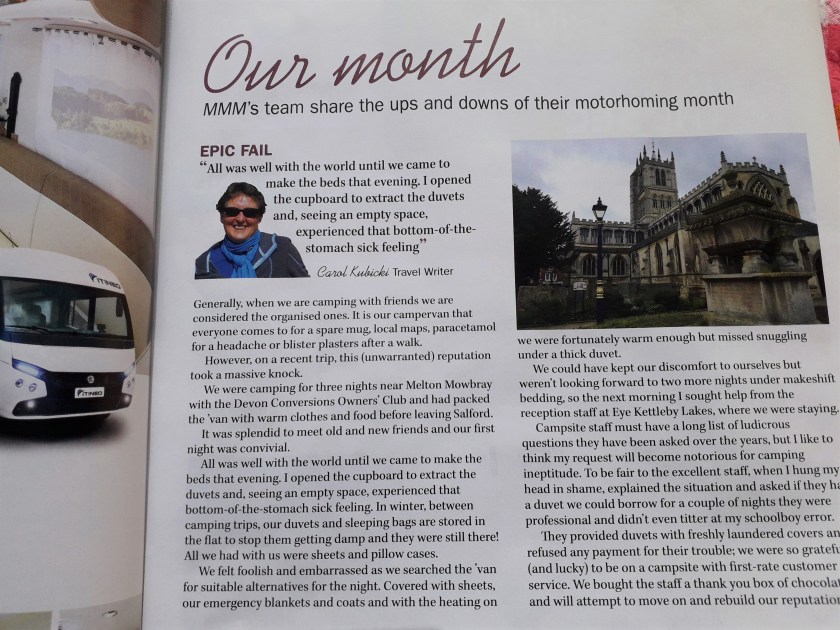
Is it just us or does every campervan owner return from a long trip away in their ‘van with a long list of things that need replacing, fixing, taking out of the ‘van or buying. For me, this to-do list comes into being a few weeks in to the trip. I will have a bright idea or break something, find a sheet of scrap paper, usually the back of a campsite receipt or map, and a pen [these are on the list too, we always have a stack of them in the ‘van] and scribble down whatever it is I don’t want to forget. The list will get shoved under my pile of t-shirts and as the weeks go by other things will come up and I will grab a pen and add it to the list.
Some of the things on the list are mundane replacements, things we must remember to buy when we are back in the UK. Another packet of Kwells seasickness tablets is a good example of this sort of thing; this could easily get forgotten in the excitement of being home and only be noticed when I next start to feel queasy on a pitching and rolling ship.
Others things on the list are expensive purchases that are more challenging for two frugal folk to deal with. These things will sit on the list for a while [at least one month] for due consideration before the money is spent. New cycling shorts are this sort of thing. We tend to do more and longer cycle rides in the warmth of southern Europe and this can highlight the shortcomings of the gear we have. New cycling shorts clearly seemed important at the time to make it on to the list but at the moment we are minded to think that the old ones will do another year.
Replacement MP3 speakers could be on the ‘due consideration’ list as these also cost money, except that I find dropping off to sleep to a podcast on the MP3 player helps me deal with the constant ringing in my ears that comes with tinnitus. The speakers that I have found suit me best have done many years regular use but they are no longer reliable and another set is urgently needed.
The reversing sensors on our Blue Bus started mis-firing part way through our holiday. Annoyingly, they starting beeping as soon as reverse was engaged even if there was nothing behind the ‘van for many metres. The Renault came with reversing sensors and we thought we would hardly use them, having managed without before. But there is really no view out of the back window of the Renault and so these have proved to be a useful bit of kit. At £170 to replace we will take a deep breath before we go ahead.
Some of the things on the list don’t need us to spend any money – hurrah! We have carried a hairdryer in the campervan since we had it but realised on our last trip that we had never actually used it! I have no idea why it took three years to realise that we both have short hair that dries quickly, particularly in the sun. The hairdryer was taking up space we could use more efficiently and has now gone to the charity shop.
It has taken us sometime to get round to this but we have now put our music on a flash drive that plugs in to a USB on the radio of our Renault. We had expected to be able to use the MP3 player through the van’s radio but this turned out to be impossible, perhaps due to the age of our MP3 player. Then we had a flash [pun intended] of inspiration and tried a portable drive. This works well and takes up much less room than the pile of CDs we had before. Now we can rock to our whole music collection as we drive!
The temporary mirror inserts went on the wish list after the expensive Spanish mirror jousting incident. We bought one each for the right and left mirrors on Ebay and hope these will be enough to get us home if the same happens again. If these work, they will enable us to put off buying a replacement wing mirror until we can do this online from home and we can then fit it ourselves much more cheaply.
Living in the north of England with our wonderful soft water we didn’t realise kettle descaler was even a thing until we travelled abroad. The mineral-rich hard water in most European countries might be good for our bones but certainly clogs up the kettle and the ‘van’s water pump, as we discovered to our cost last year. In a two month long trip we will descale the kettle one or two times to keep it working efficiently and always keep some in the ‘van.
The list from each holiday is always different and partly tells the story of some of the things that have happened on our trip and the places we have been. What does your post-holiday to-do list look like?









